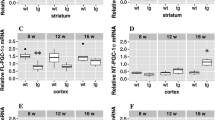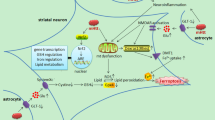Abstract
Huntington’s disease is an autosomal dominant neurodegenerative disease caused by a CAG repeat expansion in the huntingtin gene. Heart disease is the second leading cause of death in patients with Huntington’s disease. This study was to evaluate whether cardiac Fas-dependent and mitochondria-dependent apoptotic pathways are activated in transgenic mice with Huntington’s disease. Sixteen Huntington’s disease transgenic mice (HD) and sixteen wild-type (WT) littermates were studied at 10.5 weeks of age. The cardiac characteristics, myocardial architecture, and two major apoptotic pathways in the excised left ventricle from mice were measured by histopathological analysis, Western blotting, and TUNEL assays. The whole heart weight and the left ventricular weight decreased significantly in the HD group, as compared to the WT group. Abnormal myocardial architecture, enlarged interstitial spaces, and more cardiac TUNEL-positive cells were observed in the HD group. The key components of Fas-dependent apoptosis (TNF-alpha, TNFR1, Fas ligand, Fas death receptors, FADD, activated caspase-8, and activated caspase-3) and the key components of mitochondria-dependent apoptosis (Bax, Bax-to-Bcl-2 ratio, cytosolic cytochrome c, activated caspase-9, and activated caspase-3) increased significantly in the hearts of the HD group. Cardiac Fas-dependent and mitochondria-dependent apoptotic pathways were activated in transgenic mice with Huntington’s disease, which might provide one of possible mechanisms to explain why patients with Huntington’s disease will develop heart failure.






Similar content being viewed by others
References
Lanska, D. J., Lavine, L., Lanska, M. J., & Schoenberg, B. S. (1988). Huntington’s disease mortality in the United States. Neurology, 38, 769–772.
The Huntington’s Disease Collaborative Research Group (1993). A novel gene containing a trinucleotide repeat that is expanded and unstable on Huntington’s disease chromosomes. The Huntington’s Disease Collaborative Research Group. Cell 72:971–983.
Perutz, M. F. (1999). Glutamine repeats and neurodegenerative diseases: Molecular aspects. Trends in Biochemical Sciences, 24, 58–63.
Chiu, E., & Alexander, L. (1982). Causes of death in Huntington’s disease. Medical Journal of Australia, 1, 153.
Schroeder, A. M., Loh, D. H., Jordan, M. C., Roos, K. P., & Colwell, C. S. (2011). Baroreceptor reflex dysfunction in the BACHD mouse model of Huntington’s disease. PLoS Currents, 3, RRN1266.
Kiriazis, H., Jennings, N. L., Davern, P., Lambert, G., Su, Y., Pang, T., et al. (2012). Neurocardiac dysregulation and neurogenic arrhythmias in a transgenic mouse model of Huntington’s disease. The Journal of Physiology, 590, 5845–5860.
Sathasivam, K., Hobbs, C., Turmaine, M., Mangiarini, L., Mahal, A., Bertaux, F., et al. (1999). Formation of polyglutamine inclusions in non-CNS tissue. Human Molecular Genetics, 8, 813–822.
Pattison, J. S., Sanbe, A., Maloyan, A., Osinska, H., Klevitsky, R., & Robbins, J. (2008). Cardiomyocyte expression of a polyglutamine preamyloid oligomer causes heart failure. Circulation, 117, 2743–2751.
Pattison, J. S., & Robbins, J. (2008). Protein misfolding and cardiac disease: Establishing cause and effect. Autophagy, 4, 821–823.
Melkani, G. C., Trujillo, A. S., Ramos, R., Bodmer, R., Bernstein, S. I., & Ocorr, K. (2013). Huntington’s disease induced cardiac amyloidosis is reversed by modulating protein folding and oxidative stress pathways in the Drosophila heart. PLoS Genetics, 9, e1004024.
Wood, N. I., Sawiak, S. J., Buonincontri, G., Niu, Y., Kane, A. D., Carpenter, T. A., et al. (2012). Direct evidence of progressive cardiac dysfunction in a transgenic mouse model of Huntington’s disease. Journal of Huntington’s Disease, 1, 57–64.
Buonincontri, G., Wood, N. I., Puttick, S. G., Ward, A. O., Carpenter, T. A., Sawiak, S. J., & Morton, A. J. (2014). Right ventricular dysfunction in the R6/2 transgenic mouse model of Huntington’s disease is unmasked by dobutamine. Journal of Huntington’s Disease, 3, 25–32.
Mihm, M. J., Amann, D. M., Schanbacher, B. L., Altschuld, R. A., Bauer, J. A., & Hoyt, K. R. (2007). Cardiac dysfunction in the R6/2 mouse model of Huntington’s disease. Neurobiology of Disease, 25, 297–308.
Bishopric, N. H., Andreka, P., Slepak, T., & Webster, K. A. (2001). Molecular mechanisms of apoptosis in the cardiac myocyte. Current Opinion in Pharmacology, 1, 141–150.
Kubasiak, L. A., Hernandez, O. M., Bishopric, N. H., & Webster, K. A. (2002). Hypoxia and acidosis activate cardiac myocyte death through the Bcl-2 family protein BNIP3. Proceedings of the National Academy of Sciences of the United States of America, 99, 12825–12830.
Brown, G. C., & Borutaite, V. (1999). Nitric oxide, cytochrome c and mitochondria. Biochemical Society Symposia, 66, 17–25.
Bang, S., Jeong, E. J., Kim, I. K., Jung, Y. K., & Kim, K. S. (2000). Fas-and tumor necrosis factor-mediated apoptosis uses the same binding surface of FADD to trigger signal transduction. A typical model for convergent signal transduction. Journal of Biological Chemistry, 275, 36217–36222.
Barnhart, B. C., Alappat, E. C., & Peter, M. E. (2003). The CD95 type I/type II model. Seminars in Immunology, 15, 185–193.
Jeremias, I., Stahnke, K., & Debatin, K. M. (2005). CD95/Apo-1/Fas: Independent cell death induced by doxorubicin in normal cultured cardiomyocytes. Cancer Immunology, Immunotherapy, 54, 655–662.
Aggarwal, B. B., Bhardwaj, U., & Takada, Y. (2004). Regulation of TRAIL-induced apoptosis by ectopic expression of antiapoptotic factors. Vitamins and Hormones, 67, 453–483.
Gross, A., Yin, X. M., Wang, K., Wei, M. C., Jockel, J., Milliman, C., et al. (1999). Caspase cleaved BID targets mitochondria and is required for cytochrome c release, while BCL-XL prevents this release but not tumor necrosis factor-R1/Fas death. Journal of Biological Chemistry, 274, 1156–1163.
Chiang, M. C., Chen, C. M., Lee, M. R., Chen, H. W., Chen, H. M., Wu, Y. S., et al. (2010). Modulation of energy deficiency in Huntington’s disease via activation of the peroxisome proliferator-activated receptor gamma. Human Molecular Genetics, 19, 4043–4058.
Chou, S. Y., Lee, Y. C., Chen, H. M., Chiang, M. C., Lai, H. L., Chang, H. H., et al. (2005). CGS21680 attenuates symptoms of Huntington’s disease in a transgenic mouse model. Journal of Neurochemistry, 93, 310–320.
Mielcarek, M., Inuabasi, L., Bondulich, M. K., Muller, T., Osborne, G. F., Franklin, S. A., et al. (2014). Dysfunction of the CNS-heart axis in mouse models of Huntington’s disease. PLoS Genetics, 10, e1004550.
Olmesdahl, P. J., Gregory, M. A., & Cameron, E. W. (1979). Ultrastructural artefacts in biopsied normal myocardium and their relevance to myocardial biopsy in man. Thorax, 34, 82–90.
Bates, G. P., Mangiarini, L., Mahal, A., & Davies, S. W. (1997). Transgenic models of Huntington’s disease. Human Molecular Genetics, 6, 1633–1637.
Nagai, Y., Inui, T., Popiel, H. A., Fujikake, N., Hasegawa, K., Urade, Y., et al. (2007). A toxic monomeric conformer of the polyglutamine protein. Nature Structural and Molecular Biology, 14, 332–340.
Zhang, Q. C., Yeh, T. L., Leyva, A., Frank, L. G., Miller, J., Kim, Y. E., et al. (2011). A compact beta model of huntingtin toxicity. The Journal of Biological Chemistry, 286, 8188–8196.
Takahashi, T., Kikuchi, S., Katada, S., Nagai, Y., Nishizawa, M., & Onodera, O. (2008). Soluble polyglutamine oligomers formed prior to inclusion body formation are cytotoxic. Human Molecular Genetics, 17, 345–356.
Hsiao, H. Y., Chiu, F. L., Chen, C. M., Wu, Y. R., Chen, H. M., Chen, Y. C., et al. (2014). Inhibition of soluble tumor necrosis factor is therapeutic in Huntington’s disease. Human Molecular Genetics, 23, 4328–4344.
Luo, S., & Rubinsztein, D. C. (2009). Huntingtin promotes cell survival by preventing Pak2 cleavage. Journal of Cell Science, 122, 875–885.
Zhang, Y., Leavitt, B. R., van Raamsdonk, J. M., Dragatsis, I., Goldowitz, D., MacDonald, M. E., et al. (2006). Huntingtin inhibits caspase-3 activation. The EMBO Journal, 25, 5896–5906.
Shirendeb, U. P., Calkins, M. J., Manczak, M., Anekonda, V., Dufour, B., McBride, J. L., et al. (2012). Mutant huntingtin’s interaction with mitochondrial protein Drp1 impairs mitochondrial biogenesis and causes defective axonal transport and synaptic degeneration in Huntington’s disease. Human Molecular Genetics, 21, 406–420.
Li, S. H., Lam, S., Cheng, A. L., & Li, X. J. (2000). Intranuclear huntingtin increases the expression of caspase-1 and induces apoptosis. Human Molecular Genetics, 9, 2859–2867.
Zuccato, C., Valenza, M., & Cattaneo, E. (2010). Molecular mechanisms and potential therapeutical targets in Huntington’s disease. Physiological Reviews, 90, 905–981.
Acknowledgments
The authors thank Dr Yijuang Chern for offering R6/2 mice and Dr Timothy Williams for proofreading the manuscript. This study was supported by Grants from the National Science Council (NSC 100-2632-B-039-001-MY3 and NSC100-2314-B-039-016-MY) in Taiwan. This study is supported in part by Taiwan Ministry of Health and Welfare Clinical Trial and Research Center of Excellence (MOHW104-TDU-B-212-113002). Some components of the pathway diagram in the current study were modified from the Pathway Central from SABiosciences.
Conflict of interest
The authors declare no conflict of interest.
Author information
Authors and Affiliations
Corresponding author
Additional information
Chih-Yang Huang and Shin-Da Lee have contributed equally to this work.
Rights and permissions
About this article
Cite this article
Wu, BT., Chiang, MC., Tasi, CY. et al. Cardiac Fas-Dependent and Mitochondria-Dependent Apoptotic Pathways in a Transgenic Mouse Model of Huntington’s Disease. Cardiovasc Toxicol 16, 111–121 (2016). https://doi.org/10.1007/s12012-015-9318-y
Published:
Issue Date:
DOI: https://doi.org/10.1007/s12012-015-9318-y




